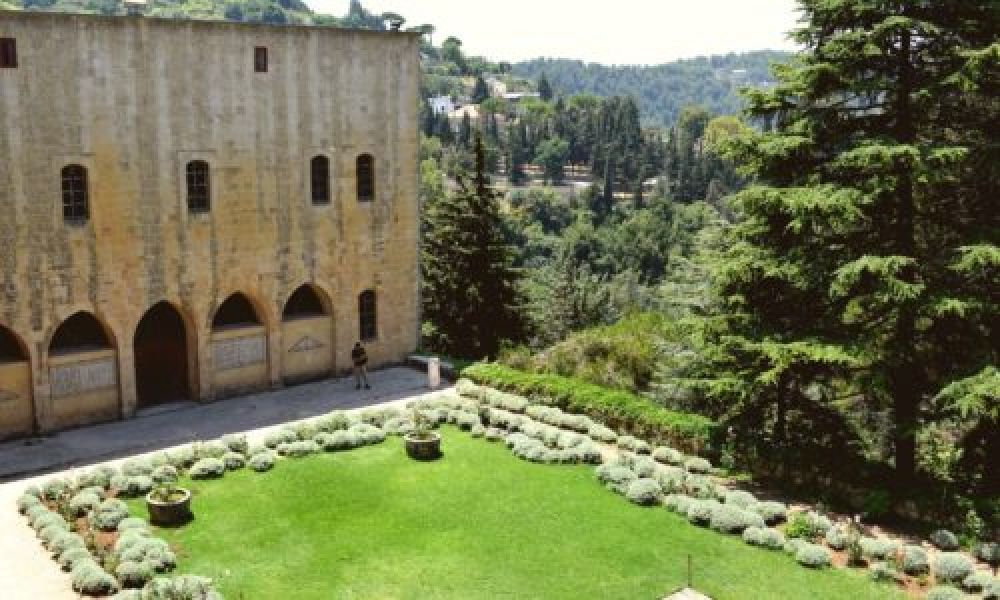

The Beiteddine Palace, a masterpiece of Lebanese architecture with its intricate designs and detailed mosaics, stands proudly in the Chouf Mountains of Lebanon. The palace complex, which began construction in the early 19th century under Emir Bashir Shihab II, has since been a beacon of tourism and historical intrigue in Lebanon. Its most notable features include the lavish interior, the majestic courtyards, and particularly the Lower Gardens and Fountains, which are a significant draw for tourists from around the world.
The Lower Gardens are a splendid example of traditional Islamic garden design. They are meticulously landscaped with a variety of flora and beautifully lined with cypress trees, providing a refreshing oasis amidst the grandeur of the palace. The symmetrical layout includes water channels that lead to elegant fountains, which not only offer an aesthetic appeal but also a tranquil auditory experience with the gentle sound of flowing water. Visitors to the gardens can bask in the peaceful ambiance and admire the craftsmanship of the stone fountains that have stood the test of time.
This area of the palace is particularly famous during the annual Beiteddine Festival, which features a series of performances and concerts in the palace's outdoor spaces, drawing in a multitude of visitors and allowing them to enjoy the harmonious blend of nature, history, and culture.
Lebanon's history of tourism goes back several decades and has seen many changes over time. In the 1960s and early 1970s, Lebanon, particularly Beirut, was known as the "Paris of the Middle East" and was a premier tourist destination. Visitors were attracted to its vibrant cultural scene, beautiful landscapes, and rich history. With its well-established hospitality sector, Lebanon hosted international tourists and served as a hub for intellectuals, celebrities, and politicians.
However, the onset of the Lebanese Civil War in 1975 brought this golden age of tourism to a halt. The war lasted until 1990 and had a severe impact on the country's infrastructure and economy. It was not until the war ended that Lebanon began to rebuild its tourism industry, investing in reconstructing its infrastructure, preserving its historical sites, and promoting its cultural heritage.
Over the past few decades, Lebanon has worked to revive its tourism by capitalizing on its diverse attractions, including ancient historical sites, a delicious culinary scene, and vibrant nightlife. Against challenges, the resilience of the Lebanese people has played a significant role in the recovery and promotion of tourism, positioning Lebanon once again as a unique and appealing destination for international travelers.
In recent years, tourism trends in Lebanon have been adapting to global movements while highlighting the country's distinctive character. One of the central trends is the rising interest in eco-tourism and sustainable travel. Travelers are becoming more aware of their environmental impact and seek experiences that are both environmentally responsible and culturally enriching.
Furthermore, there is an increasing trend towards experiential travel, where visitors are looking for authentic and immersive experiences. This includes staying in boutique hotels, participating in local workshops, exploring rural regions, and engaging in traditional Lebanese cultural activities.
The Lebanese gastronomy scene is also a crucial aspect of the newest tourism trends, with a focus on food tourism. Visitors often engage in culinary tours, wine tasting in the Bekaa Valley, and cooking classes to learn about and enjoy the celebrated Lebanese cuisine.
Finally, the country's drive to advance digital transformation in its tourism sector has led to the increase in online resources and mobile applications aimed at enhancing the tourism experience. This digital push enables travelers to access information easily and tailor their journeys in Lebanon to their preferences, ensuring a personalized and unforgettable visit.